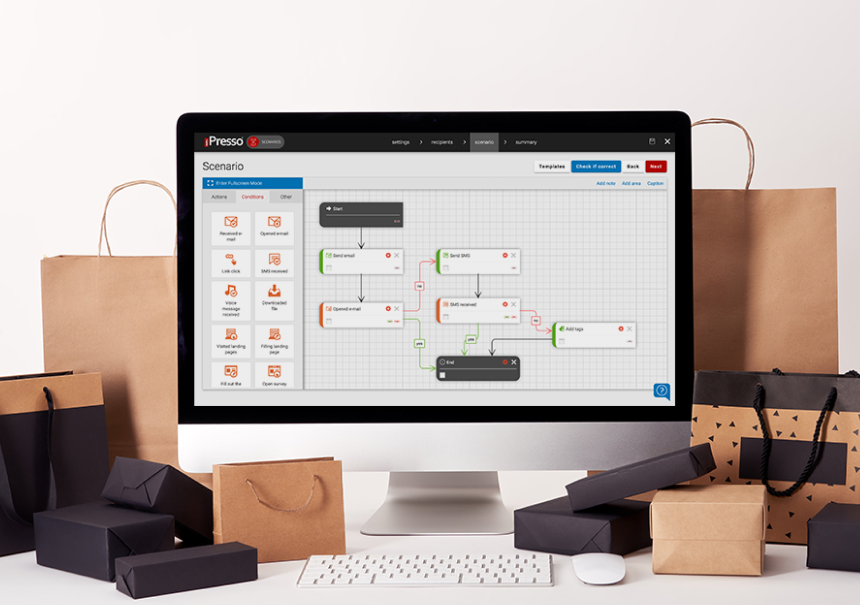Marketing Automation: what to avoid

If you read our blog at least occasionally, you know we are big fans of marketing automation. And that’s true; with this technology, you can save a lot of time, reach your customers more effectively, and concentrate just on the most important aspects of your marketing strategy. However, as always, there are some things to steer clear of, and that’s what we want to discuss in this post.
Marketing automation can only do its job when it’s properly conceived and implemented. You cannot just wake up one day and say, “From now on, I’m implementing marketing automation in my business!” You need a strategy and a selection of tools that will make the most significant difference in your particular situation.
This is especially important if you’ve just started and your budget is limited. Believe us, it’s better to start with one tool/feature, master it, and then move to the next one instead of implementing dozens of different tools simultaneously. Focus on one tool, especially given now, there are AIO (all-in-one) tools like iPresso, where you can have access to many different functions within just one dashboard.
With this short introduction done, let’s have a look at what to avoid when it comes to marketing automation. We’ve made a list of eight elements.
No goals and metrics
Sure, marketing automation can work in your company even if you have no goals and no metrics to follow, but thinking about them and adding them will help you assess whether MA truly makes your work more effective. Typically, marketing automation metrics refer to such elements as time savings, and the number of customers reached within a specific timeframe. If, thanks to MA, you can reach 10,000 customers in just 10 minutes, that’s a clear indication that marketing automation is making a real difference in your business. But in order to know that, you need to track those metrics.
Spamming
So, yes, we can now send thousands of messages to people. Great, let’s flood them with our emails and push notifications, right? Wrong! Spamming is ALWAYS a detrimental and illegal practice. And we know that having the possibility of sending thousands of emails daily without the need to send each and every one of them manually is tempting. Perhaps you’ve heard that cold outreach is a numbers game – the more emails you send out, the more clients you get.
But the truth is, there is just a fine line between effective cold outreach and spamming. The same is true when it comes to your customers – yes, you can flood them with dozens of newsletters monthly, but it doesn’t mean that you should.
Unrefined databases
You built your email/customer database years ago, and now you want to start reaching out to those people using marketing automation. You need to clean and organize your database first. It is very likely you have some double/wrong entries in your database. Here’s an example: When your employee was onboarding a new customer many years ago, they made a typo and added the johnsmith@gmailcom address instead of johnsmith@gmail.com to your database.
Now, imagine you have over 100 such addresses. Sending emails to them without checking whether they are updated and correct first will decrease your delivery rates and can even hurt your domain’s reputation. If that’s your first time with MA, start by organizing and cleaning everything.
No tests
How do you know your marketing automation system works the way you want? You need to test it! Testing is very important in everything tech-related. Tests show potential glitches and malfunctions that you need to deal with before your system goes live.
Once you set up a new MA system or scenario, run it first with some test email addresses to make sure it acts exactly as intended. It will save you a lot of time and potentially also some embarrassment. 🙂
Set and forget
This is a related problem – you cannot just set everything and forget about marketing automation. In marketing, everything is in constant flux, and you need to keep tabs on what’s going on. Some scenarios/algorithms that used to work well in the past are now outdated, and they need to be improved. We’re not saying you should modify your algorithms all the time, but you should check how your MA works, at least from time to time, and see if any corrections are needed.
Automate EVERYTHING
Again, MA can be tempting. “We’ve automated this, and it worked brilliantly; let’s automate everything else!” On the one hand, such a way of thinking is reasonable – after all, you can save even more time, right? But there is a big risk you need to keep in mind – the risk of losing the human touch.
People, in general, like to work with other people. This is true in the B2B setup as well. Automating everything in your company will give it a slightly robotic face, and that’s not something you want. There are some things that need to be performed by humans, even if automatic systems and algorithms can do that for you. Web copy is a good example. Sure, you can ask ChatGPT to write the whole website for you, but the text you will receive will be generic and impersonal. If you want to attract customers and show them that you care about them, you need to write those texts yourself or with a professional copywriter.
Only this way can you present the real human face of your business. Our advice? Automate only those elements that are relatively simple and mundane. For example, you can automate sending order summary messages but not onboarding emails, especially if you have a service that’s tailor-made to each client.
No training
When you’re implementing a brand-new automation tool, you need to devote some time to training your team. Of course, the platform’s team can do that for you, but you need to remember about this stage of work. Make sure everyone who will be involved in using MA tools knows how to use them and how they work. Sometimes, more than one workshop is necessary.
Don’t neglect this part of the work. Imagine this scenario – there is only one person in your company who knows how to use your MA platform. At some point, they decide to move on to a different company. What happens to you? You’re left with a platform that was probably expensive, and no one knows how to use it! Of course, you can reach out to the company and ask for help, but it can take weeks before you’re back on track.
Avoiding this scenario is crucial and extremely easy – all you have to do is train everyone involved in this part of your marketing.
No integrations
Sometimes, marketing automation algorithms can work on their own. But most of the time, they need to be integrated with other systems in your company. Those systems include:
- CRM
- E-commerce platform
- Website/CMS
- Web/mobile app
- Social media platforms
Thanks to common communication protocol known as API, you can integrate your marketing automation platform with almost any marketing tool you use in your company. But you need to go through the integration stage as early as possible. Otherwise, your system will not be as effective as possible, and you’ll end up losing money, time, or both.
Summary
Of course, that’s not the whole list of everything that could go wrong, but these elements are common regardless of the industry or company size. If you want to start using marketing automation in your company, start with a strategy that will be then implemented step by step. With such a meticulous approach, you will be able to make the most of your MA algorithms and protect yourself from typical risks and problems.
If you’d like to see how marketing automation works in real life, we invite you to start a free trial period with our platform. Just go here and fill out this short contact form!



